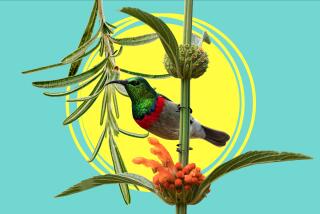Many Plants Will Grow in Low Light
- Share via
Question: I live in an apartment and don’t have much light, but I’d like to grow houseplants. Is it possible?
S.D., Fullerton
Answer: You’re in luck because there are many indoor plants that thrive in low light and few that can endure bright southern or Western exposure.
Most of the plants that grow indoors are subtropical or tropical, and many come from the jungle floor, so they’re already shaded by trees in nature and survive on low light.
Low light, however, doesn’t mean no light.
All plants need some natural light. Brief sun at some point during the day is usually enough for a variety of plants. Plants that will take low-light conditions include fiddeleaf fig (Ficus lyrata), rubber plant (Ficus elastica), Sansevieria, spider plant (Chlorophytum), cast-iron plant (Aspidistra), pothos (Epipremnum aureum) (grows just about anywhere!), Chinese evergreen (Aglaonema commutatum), Dieffenbachia, parlor palm (Chamaedorea elegans), Oxalis regnellii, split-leaf philodendron (Monstera deliciosa), Peperomia, elephant’s ear (Alocasia), prayer plant (Maranta) and in flowering plants, the black-leafed orchid Ludisia discolor, Anthurium crystallinum and orange jasmine (Murraya paniculata).
Successfully growing plants in low-light conditions takes some experimentation. Keep an eye on plants for signs of light deficiency, which include etiolation (legginess) and small, spindly growth. If a plant doesn’t look happy someplace, try another location, which may have a little more light.
Also keep the following additional tips in mind:
* Watering. Generally, plants in low-light conditions need less water than those in sunny locales. Before watering, stick a finger in the soil to the first knuckle or use a moisture meter. Most plants like to go a little dry, and those in darker locations will dry out much more slowly. Also avoid watering at night.
* Fertilizing. Plants in low-light conditions don’t grow as quickly as those in bright light, but they do need to be fed. Fertilize most plants spring through summer, tapering off in fall. You can feed once or twice a month, or try quarter-strength fertilizer every time you water. Use a well-balanced food for foliage plants and an orchid or African violet food for flowering ones.
* Pests. Because they are living in some stress, low-light houseplants tend to be susceptible to pests. Check plants each time you water them for signs of mealybugs, spider mites and scale. Treat any problems promptly.
* Repotting. Don’t over pot. Wait until low-light plants are root-bound before repotting, as too big a pot will result in continually wet soil and eventual root rot. A plant is generally root-bound when roots are seen coming out of the bottom of the container or when water rushes through each time you water. When you do pot up, go up only one size; for instance, from a 6-inch to an 8-inch container.
Have a problem in your yard? University of California Cooperative Extension (UCCE) Master Gardeners are here to help. These trained and certified horticultural volunteers are dedicated to extending research-based, scientifically accurate information to the public about home horticulture and pest management. They are involved with a variety of outreach programs, including the UCCE Master Garden hotline, which provides answers to specific questions. You can reach the hotline at (714) 708-1646 or send e-mail to ucmastergardeners @yahoo.com. Calls and e-mail are picked up daily and are generally returned within two to three days.






